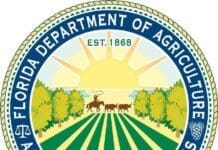 By Carolyn Newcomer Ketchel, Okaloosa County Commissioner, District 2
By Carolyn Newcomer Ketchel, Okaloosa County Commissioner, District 2
Nothing is more essential to life than water. Most of us can only live three days without water. We are blessed to live at a time and place in history where water comes from a faucet and is clean. However, even a century ago, water had to be brought from rivers or natural springs. Water-borne diseases were part of 19th century life. A significant development was the construction of sewers to collect wastewater, which has its origins in ancient Rome. The tremendous growth of overcrowded cities in Europe and North America forced municipal sanitation to be addressed in the 19th century and early 20th century with outbreaks of typhoid and cholera. The information that follows might answer many questions and concerns.
The primary legislation governing drinking water quality is the Safe Drinking Water Act (SDWA) passed by Congress in 1974 and amended in 1986 and further strengthened in 1996. The U.S. Environmental Protection Agency (EPA), after consulting with the National Academy of Science, sets a Maximum Contaminant Level (MCL) for each regulated substance. Periodically, these standards are reviewed and refined based on scientific and technological advancements.
Contaminants that can cause acute health effects are monitored daily. Others are monitored weekly and monthly. Testing and monitoring results are reported regularly to the state health department and are available to the public. Strict adherence to monitoring and testing are the best guarantees for safe drinking water. The Florida Department of Environmental Protection (FDEP) and EPA ensure all requirements are followed.
In addition to the Standards of the Safe Drinking Water Act SDWA, there are other federal laws that safeguard the quality of drinking water by regulating surface and groundwater pollution, management of hazardous substances and use of chemical pesticides. Public water utilities test and monitor drinking water to meet two types of standards. The primary standards, called Maximum Contaminant Levels (MCLs), are set to protect human health and the secondary standards address aesthetic considerations such as taste, odor and appearance. Health and aesthetic aspects are the driving force behind drinking water regulations.
It would seem that “safe” drinking water would be obvious and easy to define. However, in the drinking water world this is not the case. In fact, the Safe Drinking Water Act does not clearly define what is “safe” drinking water. For Okaloosa Water and Sewer (OCWS), we categorize our drinking water as safe, because we know that we have followed strict guidelines for the treatment and delivery of drinking water. We know the water has been monitored and tested to ensure compliance with the SDWA.
The Florida Aquifer: OCWS drinking water is groundwater that is pumped out of the Florida Aquifer. This Aquifer is a limestone aquifer, so the water contains calcium, magnesium, and other minerals dissolved from the limestone. These minerals cause the water to have a slight to moderate hardness classification of water quality, the Florida Aquifer with its thick confinement layer is far superior to the water quality within the Sand and Gravel Aquifer. Fluoride is not added to our water, because we have naturally occurring fluoride in the Florida Aquifer.
Chlorine Added: The OCWS treats all drinking water at each well with chlorine disinfection which reduces hydrogen sulfide odor. Chlorine disinfection not only reduces odor but also kills pathogenic and harmful microbial activity that could be harmful in drinking water. Disinfection is one of the most vital components of delivering safe water in addition to the filtration work of the Florida Aquifer. Additionally, public utilities are required by FDEP to maintain a chlorine residual throughout the system. The chlorine residual can provide some disinfection capacity but is mainly required to ensure the water is free from microbial activity. If microbial activity comes in contact with chlorine, it is destroyed but the chlorine is consumed. If a small chlorine residual is present, it indicates the absence of any microbial activity that would ultimately consume the chlorine in the disinfection process.
PFAS Chemicals: The Unregulated Contaminant Monitoring Rule (UCMR5) list includes 30 contaminants and 29 of the contaminants are PFAS compounds. PFAS is the acronym given to “forever chemicals”, in other words, chemicals that do not break down. Scientific studies have shown that exposure to some PFAS in the environment may be linked to harmful health effects in humans and animals. There are thousands of PFAS chemicals, and they are found in many different consumer, commercial, and industrial products. This makes it challenging to study and assess the potential human health and environmental risks.
PFAS compounds are not being regulated by the EPA. Currently under the SDWA, EPA does not require testing by public water systems for PFAS. The EPA is working toward developing regulation for PFAS compounds but will likely not have those regulations before 2025.
PFAS are widely used, long lasting chemicals, which break down very slowly over time. Because of their widespread use and their persistence in the environment, many PFAS are found in the blood of people and animals all over the world and are present at low levels in a variety of food products and in the environment.
Pharmaceuticals: Pharmaceuticals are not regulated by the EPA yet, but are on the Emerging Contaminants of Concern listing. The UCMR6 list of 30 contaminants has not yet been determined, but many suspect UCMR6 (2028-2030) will focus on pharmaceuticals in much the same way UCMR5 has focused on PFAS compounds. The bad news is that the number of pharmaceutical compounds in existence are extremely vast. So, regulation by EPA will be slow. In addition, many pharmaceutical compounds are very small and it is uncertain if even reverse osmosis can fully remove these compounds. The fortunate news is that pharmaceuticals in a given water supply are, at least, from FDA approved drugs (meaning they are not toxic in and of themselves). Most pharmaceuticals are very dose dependent and are relatively ineffectual at low concentrations. Extremely low concentration is exactly what one would expect if pharmaceuticals have found their way into the Florida Aquifer given the enormous volume (limited data is available on this subject). It is also logical to assume that if PFAS compounds have not been detected in the OCWS system in part due to the Confinement Layer as well as the dilution factor, it may be logical to assume that the same would be true for pharmaceuticals.
The safe way to dispose of Pharmaceuticals is to return unused medicine to the pharmacy or to place the medicine in used coffee grounds and dispose in the garbage. DO NOT FLUSH!
We are fortunate to have a great team at OCWS that makes sure we have the best water in the Southeast. In fact, we have such healthy water, it is sought after by other states. Thanks for reading; I know you now have a better understanding of the Okaloosa Water.
Carolyn Ketchel is Okaloosa County Commissioner, District 2, CKetchel@myokaloosa.com or 850-651-7105.


























































